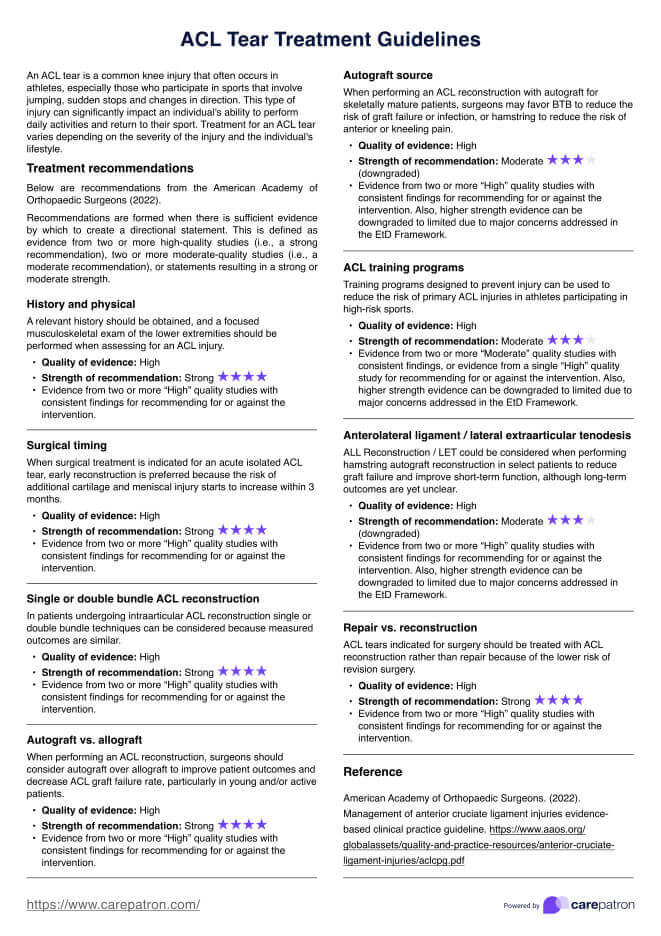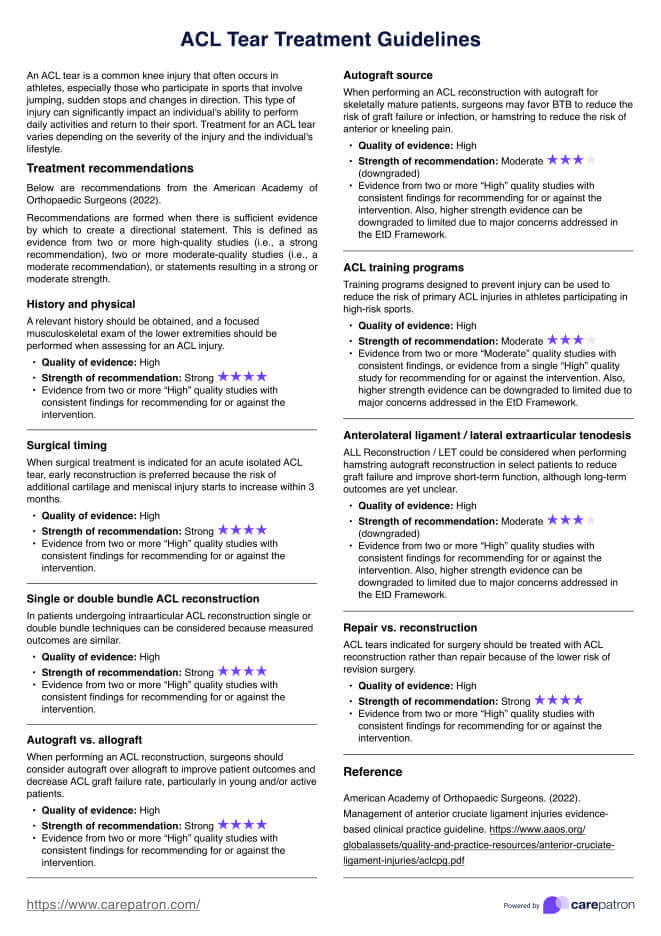ACL Tear Treatment Guidelines
Learn how to manage ACL tears with our comprehensive guidelines, featuring treatment phases, recovery tips, and preventative measures. Download now!


What are ACL tears?
An anterior cruciate ligament (ACL) tear is a common type of knee injury, often occurring during sports involving sudden stops and direction changes, such as basketball, soccer, and skiing. The ACL connects the thigh bone (femur) to the shin bone (tibia), helping to stabilize the knee joint.
Types of ACL injuries
ACL injuries, often involving the medial collateral ligament, can range from mild (slight stretching) to severe (complete ACL tear). There are three general types:
- Grade 1 sprain: The ligament is mildly damaged and slightly stretched but can still keep the knee joint stable.
- Grade 2 sprain: The ligament is stretched to the point where it becomes loose, often referred to as a partial tear of the ligament.
- Grade 3 sprain: This is a complete tear of the ligament, which has been split into two pieces, and the knee joint is unstable.
Causes and risk factors
The majority of ACL injuries occur not from contact with another player but from non-contact mechanisms such as:
- Sudden stopping or changing directions (cutting)
- Landing awkwardly from a jump
- Slowing down while running
- Direct blow to the knee (less common)
The ACL is the most commonly injured knee ligament, with estimates of 100,000 to 200,000 people in the U.S. tearing an ACL each year.
Certain factors can increase the risk of an ACL injury, including:
- Being female, possibly due to differences in anatomy, muscle strength, and hormonal influences
- Participating in sports like soccer, basketball, and skiing, which involve sudden stops and turns
- Poor conditioning
- Wearing improper footwear
- Playing on uneven surfaces
Symptoms of an ACL injury
Recognizing the symptoms of an ACL injury in the injured ligaments is crucial for timely diagnosis and effective treatment. The initial signs can be quite dramatic and usually occur during activities that involve sudden stops or changes in direction. Here are the common symptoms of an ACL injury:
- A loud "pop" sound at the time of injury
- Pain and swelling in the knee within 24 hours
- Loss of range of motion
- Tenderness along the joint line
- Discomfort while walking
ACL Tear Treatment Guidelines Template
ACL Tear Treatment Guidelines Sample
ACL injury treatment options
Treatment for an ACL injury, including potential damage to the lateral collateral ligament and posterior cruciate ligament, depends on the severity of the injury and the individual’s lifestyle and needs. Options range from conservative management to surgical intervention.
Non-surgical treatment
Non-surgical treatment may be sufficient for those with minor ACL injuries or those not heavily involved in sports requiring knee stability. This includes:
- Physical therapy: A tailored program can help strengthen the muscles around the knee and restore its function. A physical therapist will guide the patient through exercises to maintain knee flexibility and strength.
- Bracing: Wearing a knee brace can help stabilize the knee during activity.
- Activity modification: Avoiding activities that stress the knee can prevent further injury.
Surgical treatment
Surgical treatment, often involving ACL surgery, may be recommended for athletes or individuals requiring full knee stability. The most common surgical option is ACL reconstruction, which involves:
- ACL reconstruction surgery: The torn ACL is replaced with a graft taken from another tendon in the patient’s body or from a donor. This surgery is followed by several months of physical therapy to regain knee strength and mobility.
Post-treatment rehabilitation
Whether the treatment is surgical or non-surgical, rehabilitation, including physical therapy, plays a crucial role in recovery. Key elements of a rehab program include:
- Physical therapy exercises: These help to restore knee mobility, strength, and stability.
- Gradual return to activity: Carefully increasing activity levels to allow the knee to adapt without risking new injury.
How to use our treatment guidelines handout
Our ACL Tear Treatment Guidelines Handout is an essential tool for healthcare professionals. Here’s how to use it effectively:
Step 1: Familiarize with content
Review the handout to understand the included treatment phases—initial management, rehabilitation, surgical considerations, and long-term management.
Step 2: Identify the appropriate audience
This handout is intended for orthopedic specialists, sports medicine practitioners, and physical therapists who manage ACL injuries.
Step 3: Implement in clinical practice
Utilize the handout at various stages of ACL injury management, from immediate post-injury care to long-term recovery planning. It serves as a guide for both non-surgical and surgical treatment options, ensuring comprehensive care.
Benefits of using this handout
This handout serves as a vital resource in streamlining the management process, ensuring that each phase of treatment is comprehensively addressed from diagnosis to recovery. Using the ACL Tear Treatment Guidelines Handout provides several benefits:
- Comprehensive guidance: It offers a complete overview of all phases of ACL treatment—from initial assessment and non-surgical options to surgical interventions and long-term management.
- Standardization of care: The handout ensures that all patients receive care that aligns with the latest, evidence-based clinical practices, reducing variability in treatment approaches among different providers.
- Enhanced patient education: It is an educational tool that helps patients understand their treatment plan, fostering better compliance and engagement with their recovery process.
- Time efficiency: Having a structured guideline saves healthcare providers time in planning and explaining treatment protocols, allowing for more focus on patient care.
- Improved outcomes: By adhering to established guidelines, healthcare professionals can improve treatment outcomes and reduce the likelihood of complications or re-injury.
Commonly asked questions
Symptoms of an ACL tear include a popping noise at the time of injury, severe pain, rapid swelling, loss of full range of motion, tenderness along the joint line, and instability in the knee when bearing weight.
Most ACL tears occur through non-contact mechanisms, such as pivoting or landing incorrectly from a jump. Contact-based tears can happen but are less common.
Participating in sports like soccer, basketball, and skiing, being female (due to differences in anatomy and muscle strength), inadequate physical conditioning, and poor training practices increase the risk of an ACL tear.







































































































